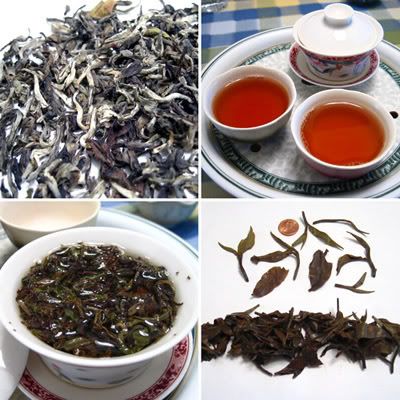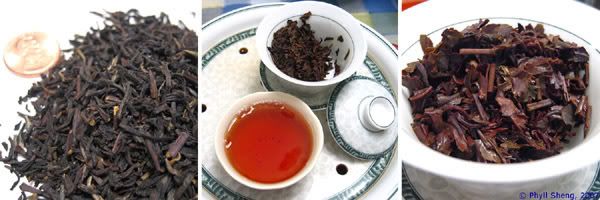With these 2, I now have (only) tasted 5 different Darjeeling oolongs (3 with T Ching). Each one was quite different from another, which I found to be quite fascinating considering that they sprang from the same region. Still, there are common denominators among them. These are my impression and what I found to be the common characteristics among the 5 Darjeeling oolongs I tasted.
The 2 oolongs below were purchased from Wild Orchid Teas. The vintage year is not mentioned by the vendor. My guess is they are 2006 teas, though I can’t be sure which season they were harvested in.
 Excellent looking dry leaves. Twisted lengthwise and mostly whole. Evenly and generously downed with white fur. Nose is complex but more subdued and subtler than the other 4 Darjeeling oolongs…of mango, muscatel, peach…a mix of tropical fruits (common Darjeeling nose). The tea also tastes subtle and quite fragrant. Light to medium body. Short aftertaste. Quite charming and especially nice when in the mood for a subtler tea. 3.5 stars (g - vg)
Excellent looking dry leaves. Twisted lengthwise and mostly whole. Evenly and generously downed with white fur. Nose is complex but more subdued and subtler than the other 4 Darjeeling oolongs…of mango, muscatel, peach…a mix of tropical fruits (common Darjeeling nose). The tea also tastes subtle and quite fragrant. Light to medium body. Short aftertaste. Quite charming and especially nice when in the mood for a subtler tea. 3.5 stars (g - vg) Hillton Ebony Oolong, Darjeeling, India
 I have depleted my entire 100gr of this tea. I brewed it in many ways: in a small gaiwan (gongfu), in a large pot, straight in the cup, iced, not iced, etc. It is a good and pleasant tea for everyday, everyway. This is one tea that I consider having as a staple for fuss-free enjoyments.
I have depleted my entire 100gr of this tea. I brewed it in many ways: in a small gaiwan (gongfu), in a large pot, straight in the cup, iced, not iced, etc. It is a good and pleasant tea for everyday, everyway. This is one tea that I consider having as a staple for fuss-free enjoyments.Closer to being a black tea (“red tea” in the Chinese tea category), it is highly oxidized. The nose resembles a fully oxidized 2nd flush tea, though slightly softer and fruitier. The liquor brews quite red when done in a gaiwan. (Otherwise, it is medium amber/brown in a 5-cups Bodum teapot with ~4 teaspoons of leaves). Tastes more robust than the other 4 teas. Quite smooth and not tannic. Refreshing and good tasting with ice! A very versatile tea that can withstand abusive brewing methods, yet delivers a pleasant enough taste. Does not break the bank ($12/100gr). 3 stars (g)
3 comments:
One thing about these Darjeeling oolongs is that I can't kick the impression of them being just a slightly lower fermented version of their red tea brothers. The taste profile mimics the better first flush teas I've had, with only minor differences.
That is my impression, too (see and taste). According to the Lochan's, however, they are closer to white tea oxidation level, although it mimics highly oxidized tea due to the "very complex agro-climatic conditions." True?
I just bought a 2006 Poobong 1st flush oolong and was reminded of this post. I agree, for the most part it's just like the 2006 Poobong 1st flush black, except it's less astringent (less broken leaves) and it cost 30% more.
Does Darjeeling have "very complex agro-climatic conditions."? Perhaps. Is this Oolong at white tea oxidation levels? uhhh....sURe...
Post a Comment